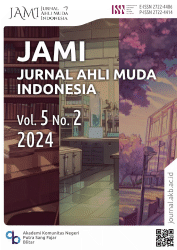Pengaruh Citra Merek dan Pemasaran Langsung Melalui Live Streaming di TikTok terhadap Keputusan Pembelian Produk Skincare
 Abstract views: 476
,
Abstract views: 476
,
 PDF downloads: 450
PDF downloads: 450
Abstract
Tujuan. Tujuan penelitian ini adalah menginvestigasi dampak Brand Image dan pemasaran melalui live streaming di TikTok efektif dalam mempengaruhi konsumen untuk memutuskan pembelian produk Skincare secara simultan.
Material dan Metode. Pendekatan kuantitatif deskriptif digunakan sebagai metode dalam penenlitian. Sampel diambil dari populasi mahasiswa melalui purposive sampling sejumlah 134 sampel. Data dikumpulkan dan diukur dengan skala Likert yang kemudian diolah menggunakan SPSS versi IBM 21. Hasil pengolahan data dianalisa dengan metode regresi linier berganda.
Hasil. Temuan dari penelitian ini menunjukkan adanya pengaruh positif Brand Image yang menggunakan platform Live Streaming di TikTok memberikan pertimbangan yang efektif konsumen dalam mengambil keputusan untuk membeli produk Skincare.
Kesimpulan. Brand Image produk Skincare mempunyai dampak positif dalam mempengaruhi tingkat kecenderungan konsumen untuk membeli produk, didukung promosi yang dilakukan melalui TikTok
Downloads
References
Etta Mamang Sangadji, Sopiah. 2014. Perilaku Konsumen : Pendekatan Praktis Disertai Himpunan Jurnal Penelitian. edited by N. WK. Yogyakarta.
Ferrinadewi, Erna. 2008. Merek & Psikologi Konsumen : Implikasi Pada Strategi Pemasaran. Yogyakarta.
Hair, Joseph F. 2010. Multivariate Data Analysis. Prentice Hall.
Herr, Paul M. 1994. “Brand Equity and Advertising: Advertising’s Role in Building Strong Brands.” Journal of Marketing Research 31.
J. Pau Peter, Jerry C. Olson. 2000. Consumer Behavior : Perilaku Dan Strategi Pemasaran. Ed. 4, cet. edited by Y. Sumihartil. Erlangga.
Lăzăroiu, George, Octav Neguriţă, Iulia Grecu, Gheorghe Grecu, and Paula Cornelia Mitran. 2020. “Consumers’ Decision-Making Process on Social Commerce Platforms: Online Trust, Perceived Risk, and Purchase Intentions.” Frontiers in Psychology 11(May):1–7. doi: 10.3389/fpsyg.2020.00890.
Leon G. Schiffman, Leslie Lazar Kanuk. 2007. Consumer Behavior. 9th ed. Pearson Prentice Hall.
Lin, Nan-Hong, and Bih-Shya Lin. 2007. “The Effect of Brand Image and Product Knowledge on Purchase Intention Moderated by Price Discount.” Journal of International Management Studies. (December).
M. Arief Algiffarya, Zakaria Wahabb, Muchsin Saggaff Shihabc, Marlina Widiyanti. n.d. “Pengaruh Celebrity Endorser, Online Advertisingdan Word of Mouthterhadap Minat Beli Konsumenpada E-Commerce Tokopedia.” doi: https://doi.org/10.25077/amar.4.2.16-31.2020.
Natthida Laosuraphon, Chompu Nuangjamnong. 2022. “Factors Affecting Customer Satisfaction, Trust, and Repurchase Intention towards Online Streaming Shopping in Bangkok, ThailandA Case Study of Facebook Streaming Platform.” AU-HIUe-Journal 2.
Rasty, Fereshte, and ;Seyyed Habibollah ; Saeid Saeida Ardakani; Peyman Ajdari Mirghafoori; n.d. “Trust Barriers to Online Shopping: Investigating and Prioritizing Trust Barriers in an Intuitionistic Fuzzy Environment.”
Saputra, Dhanar Intan Surya, Sitaresmi Wahyu Handani, and Feisal Rosdiana. n.d. “Membangun Channel Live Streaming YouTube Sebagai Alternatif Media Promosi Perguruan Tinggi.”
Song, Chuling; Liu, Yu-li. 2021. “The Effect of Live-Streaming Shopping on the Consumer’s Perceived Risk and Purchase Intention in China.”
Xian Guo Li, Xia Wang, Yu Juan Cai. 2011. “Corporate-, Product-, and User-Image Dimensions and Purchase Intentions The Mediating Role of Cognitive and Affective Attitudes.” JOURNAL OF COMPUTERS 6.
Ye Diana Wang, Henry H. Emurian. 2005. “An Overview of Online Trust: Concepts, Elements, and Implications.”
Copyright (c) 2025 Hardining Estu Murdinar , Sandi Eka Suprajang, Nunuk Latifah

This work is licensed under a Creative Commons Attribution-ShareAlike 4.0 International License.
Authors who publish with this journal agree to the following terms:
1. Copyright on any article is retained by the author(s).
2. The author grants the journal, right of first publication with the work simultaneously licensed under a Creative Commons Attribution License that allows others to share the work with an acknowledgment of the work’s authorship and initial publication in this journal.
3. Authors are able to enter into separate, additional contractual arrangements for the non-exclusive distribution of the journal’s published version of the work (e.g., post it to an institutional repository or publish it in a book), with an acknowledgment of its initial publication in this journal.
4. Authors are permitted and encouraged to post their work online (e.g., in institutional repositories or on their website) prior to and during the submission process, as it can lead to productive exchanges, as well as earlier and greater citation of published work.
5. The article and any associated published material is distributed under the Creative Commons Attribution-ShareAlike 4.0 International License




